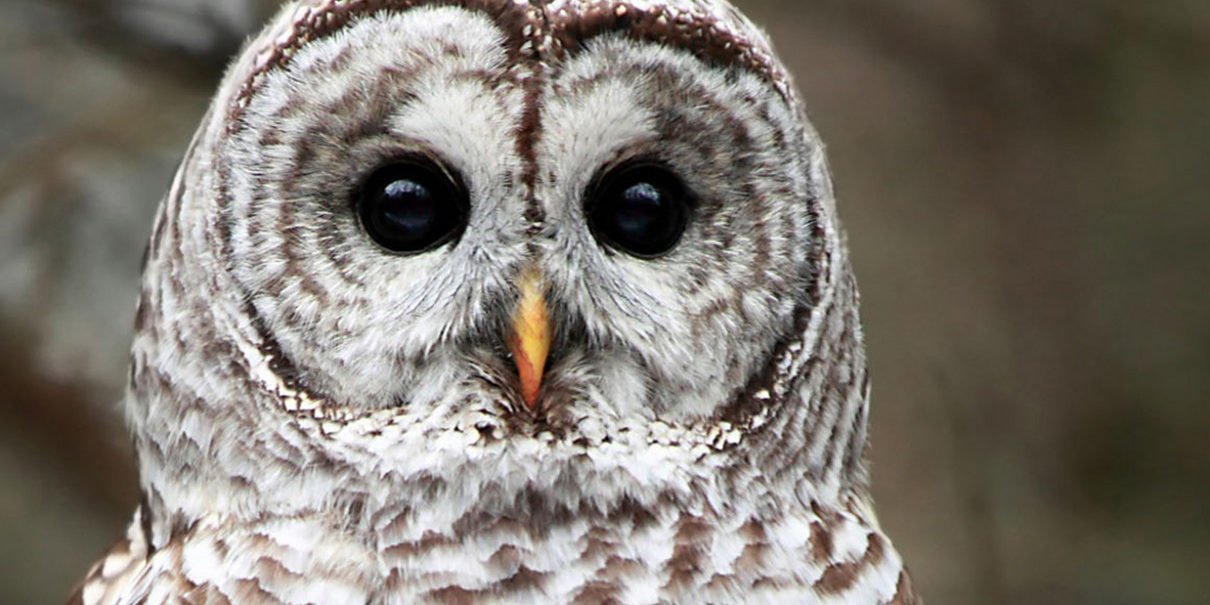Bird of The Week: Barred Owl
SCIENTIFIC NAME: Strix varia
POPULATION: 3.2 million
TREND: Stable
HABITAT: Moist forests, wooded swamps, woodlands near water
Dark-eyed, with a scaled breast and striped belly, the Barred Owl is nearly as large as the Great Horned Owl but with different markings and no ear-tufts. The Great Horned Owl is much more aggressive, and will prey upon other owls if the opportunity arises. As a result, Barred Owls tend to avoid areas with resident Great Horned Owls.
Only a few other North American owl species have dark eyes: the closely related Spotted Owl, the tiny Flammulated Owl of western pine forests, and the widespread Barn Owl.
Very much an adaptable generalist, the Barred Owl occurs in a variety of humid woodland habitats across a wide and expanding range. From region to region, this raptor readily adjusts to seasonal changes in prey availability.
Amphibian Assault
Although widely studied, the Barred Owl retains some mysteries that beg further investigation. Analysis of owl pellets — the regurgitated, indigestible remains of prey composed primarily of bones, fur, and feathers — reveals that overall, small mammals constitute much of the Barred Owl diet. Not much surprise there, but in some areas, amphibians account for a quarter of the diet.
It’s hard to gauge just how important these cold-blooded creatures are to the owls because frogs, toads, and salamanders have soft bones and thin skin that quickly decompose and often go undetected in pellets. Barred Owls have been known to frequent frog breeding pools. They certainly live in many habitats rich in amphibians.
Spooky Swamp Owl
The Barred Owl is widespread in North America, inhabiting most of the eastern half of the continent from Florida north to southern Canada. Along with the Red-shouldered Hawk, it is a characteristic raptor of lowland swamps and forests, but is also found in cooler upland habitat, in the mountains of northern Vermont, for example. This owl has also spread westward in the northern part of its range — a cause for concern, as they compete and hybridize with the threatened Northern Spotted Owl.
The Barred Owl belts out a loud, resounding hoo, hoo, too-HOO; hoo, hoo, too-HOO, ooo, often phrased as “Who, cooks, for-you? Who, cooks, for-you, all?” These calls are often heard in a series of eight, giving rise to one of this owl’s folk names: “Eight-Hooter.”
Other calls include hoo-hoo, hoo-WAAAHH, and hoo-WAAAHHH calls, used in courtship. Mated Barred Owl pairs often duet, resulting in a cacophony of weird howls, yelps, and raucous squalls, which can be unnerving if the listener doesn’t know the source.
Babies Branching Out
Although Barred Owls call year-round, their courtship activities begin in February, with breeding occurring between March and August. Males display to females by swaying back and forth with raised wings while sidling along a branch. Courtship feeding and mutual preening also occur. These birds mate for life and maintain the same territories and nest sites for many years.
Barred Owls often nest in cavities but will also use abandoned hawk, crow, or squirrel nests. The male brings food to the female while she is on the nest. The species is single-brooded but has a long breeding season, which allows for the laying of replacement clutches if the first clutch or brood is lost. Parents care for the young for at least four months, longer than most other owls.
Four to five weeks after hatching, the still-flightless, downy owlets clamber from the nest using their strong feet and talons, beginning to explore the branches of their nest tree. They can often be seen exercising their wings and making short, clumsy hops through the tree foliage. This phenomenon, known as “branching,” also occurs in other raptor species, including the Bald Eagle. At this “brancher” stage, owlets are still fed by their parents. They depend upon them until they are able to fly, at about 10 weeks of age. Barred Owlets remain with their siblings throughout the summer, then strike out on their own in early fall when their parents slowly wean them from feedings.
A Reason to Keep Dead Trees Standing
Although Barred Owls are fairly common in many areas and the species’ range continues to expand in the West, many of these birds are injured and killed by collisions with cars and fencing. Often tied to mature forests, and needing large dead and dying trees for nesting and roosting, the species is also vulnerable to habitat loss.
ABC’s BirdScapes approach to bird conservation helps to protect habitats throughout the Americas, including the forests Barred Owls share with Neotropical migrant birds such as the Wood Thrush, Hooded Warbler, and Yellow-billed Cuckoo.
Rodenticides pose another threat. Barred Owls may become sick and die when they consume poisoned rodents. ABC and partners’ efforts to ban rodenticides that secondarily poison predators resulted in an agreement in 2014 to remove harmful compounds from sale to consumers, helping to protect owls and other raptors, such as the Eastern Screech-Owl and Golden Eagle.
Source: American Bird Conservancy (abcbirds.org)


